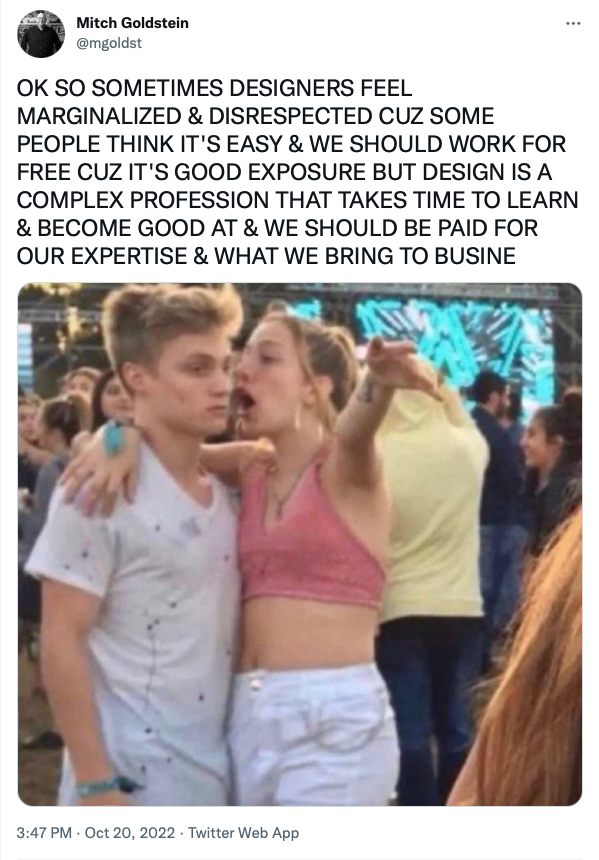The Vapidity of Design PR
At the beginning of the year, London’s Design Museum announced an upcoming exhibition about design at Netflix. The ‘immersive’ exhibition will celebrate Netflix’s ‘design journey’ and ‘their underpinning philosophy’. I want to set aside the merits of an exhibition about Netflix at a major design museum for a second and instead talk about the language in this press release, mostly because I feel like I keep thinking about, almost a year later. Here’s a quote from it attributed to Steve Johnson, the VP of Design at Netflix:
When something is designed well, it makes life easier, gives us joy and brings people together. And just like entertainment, design can fundamentally change the way we live our lives. At Netflix, building an intuitive, seamless experience has been at the heart of our business for the last 25 years: from our very early days as a mail-order DVD company, to our role today bringing entertainment to homes and devices around the world. Design plays a key role in connecting our members with great stories.
I rolled my eyes as I read this, reading once again these empty platitudes that designers throw around in press releases like this. This is not Johnson’s fault, necessarily, and I don’t mean to single out Netflix specifically. A few days before this announcement, Wallpaper ran a big feature of what it’s like inside the design teams at Apple that also featured a thousand-odd words that didn’t offer any specific insight into how Apple thinks about design today beyond comparing design to storytelling and the impact the work has in people’s lives. In talking about the Apple Watch, for example, one designer is quoted as saying “The Apple Watch is the most personal device we’ve ever designed” which, fine, but that’s the same language Jony Ive used almost ten years ago when they announced it and that Tim Cook has repeated in nearly every product announcement since.
I was thinking about this again after my recent conversations with Eva Hagberg and Tripp Mickle on Scratching the Surface. At face value, these two interviews have nothing to do with each other. Eva and I talked about her new book on Aline Saarinen and the rise of architecture public relations where Tripp’s new book is about post-Steve Jobs Apple. But dig a little deeper and these two conversations are very much in dialogue: they are both about how we talk about design; and the mythmaking that can emerge around design teams and design processes. Eva talked about how she can’t see Eero Saarinen’s work without experiencing it through the lens of Aline’s prose (the storytelling she developed to sell these buildings to the press). Tripp and I talked about Jony Ive’s (in)famous white-cube videos introducing new products, waxing poetic about chamfered edges and materiality. (These are summaries, you should listen to both episodes. I’m really proud of them!)
Both of these interviews are about selling a design to the public. As an entire public relations industry has built up around the design fields, so to has the public’s conciousness around design. Yet at the same time, our language to talk about design has devolved. Where Aline Saarinen built up narratives around Eero’s work and the concepts behind them, Jony’s videos reduce the design to a series of lustful design decisions. But both are doing the same thing: they are selling a design. The question is: what are we selling?
In my role as an editor at Eye on Design, I see this time and again in the press releases sent to us announcing new projects. Every press release features the obligatory quote from the design director and rarely do these quotes offer anything new beyond the same vapid language around how the company values design and the values of the design and how the design values people. Design is transformative! Design changes how we live our lives! Design is innovative and human-centered and collaborative and blah blah blah. No wonder I still hear designers complaining about how the public sees our work as superficial (or, worse, that people don’t understand what we do1!). When we have the opportunity to talk about ourselves and our work, we reduce it to empty platitudes.
Now, I understand the purpose (and limitations) of a press release. I know we need to get the quick quote in there and it has a role to serve in that context. I have sympathy. I’m a designer and a writer. I make my living working on design projects and writing about other people’s design projects. I can easily write a 1000 words on someone else’s work but boy, is it a challenge to write about my own work, my own processes, and my own thinking. I’m trying to do more of it and want to get better at it but I know how hard it can be to put words to these things.
Still, there must be other ways to talk about design beyond vague platitudes and superficial jargon. How do we find new ways to communicate our thinking, our process, our ideas, our value (however perceived)? How do we communicate the complexity, conceptual, often-hard to describe processes to others, outside our studios? I’ve said it before and I’ll say it over and over: for a field that prides itself on clear communication, we’re not always the best to talk about ourselves. If we still think people don’t understand what we do, we have only ourselves to blame 2.
-
An argument, by the way, that I don’t buy. ↩
-
Or maybe our work isn’t as interesting as we think it is. Maybe we use language around transformation and innovation and storytelling because so much of the work produced by graphic designers isn’t all that interesting — it’s not cultural invention but simply corporation-centered. ↩
